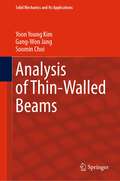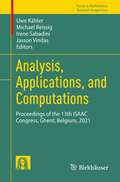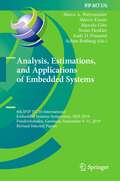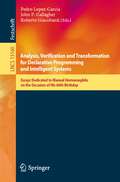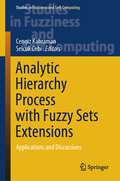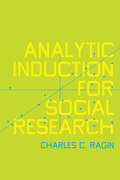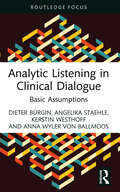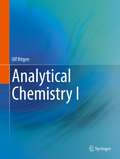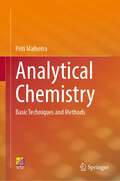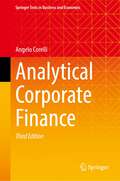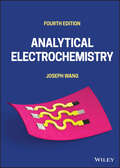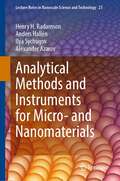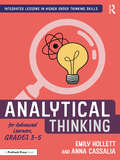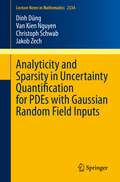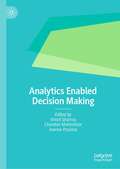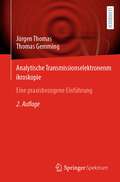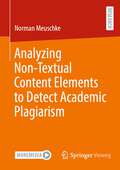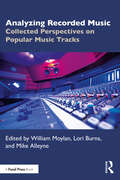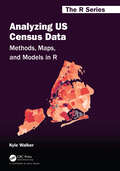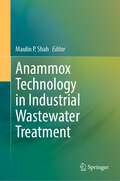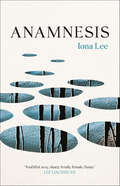- Table View
- List View
Analysis of Potential Interference Issues Related to FCC Order 20-48
by Computer Science and Telecommunications Board Division on Engineering and Physical Sciences Board on Physics and Astronomy Air Force Studies Board National Academies of Sciences, Engineering, and Medicine Committee to Review FCC Order 20-48 Authorizing Operation of a Terrestrial Radio Network Near the GPS Frequency BandsThis report reviews Federal Communications Commission order FCC 20-48, which authorized Ligado Networks LLC to operate a low-power terrestrial radio network adjacent to the Global Positioning System (GPS) frequency band. It considers how best to evaluate harmful interference to civilian and defense users of GPS, the potential for harmful interference to GPS users and DOD activities, and the effectiveness and feasibility of the mitigation measures proposed in the FCC order.
Analysis of Thin-Walled Beams (Solid Mechanics and Its Applications #257)
by Yoon Young Kim Gang-Won Jang Soomin ChoiThis book presents a comprehensive introduction to an advanced beam theory applicable to thin-walled beams of rectangular and arbitrarily-shaped cross-sections. Furthermore, it describes a unique beam-based approach to handling joint structures consisting of thin-walled beams, compiled here for the first time.This higher-order beam theory (HoBT), developed by the authors over the past two decades, uses more than six degrees of freedom (DOFs) in contrast to the classical theories, which use only six DOFs. The additional degrees of freedom describe sectional deformations such as warping and distortion. This book presents a novel systematic procedure to derive the sectional deformations analytically for rectangular cross-sections and numerically for arbitrarily-shaped cross-sections. This book is a must for structural/mechanical engineers who wish to understand and design structures involving thin-walled beams.
Analysis of the Navier-Stokes Problem: Solution of a Millennium Problem (Synthesis Lectures on Mathematics & Statistics)
by Alexander G. RammThis book revises and expands upon the prior edition, The Navier-Stokes Problem. The focus of this book is to provide a mathematical analysis of the Navier-Stokes Problem (NSP) in R^3 without boundaries. Before delving into analysis, the author begins by explaining the background and history of the Navier-Stokes Problem. This edition includes new analysis and an a priori estimate of the solution. The estimate proves the contradictory nature of the Navier-Stokes Problem. The author reaches the conclusion that the solution to the NSP with smooth and rapidly decaying data cannot exist for all positive times. By proving the NSP paradox, this book provides a solution to the millennium problem concerning the Navier-Stokes Equations and shows that they are physically and mathematically contradictive.
Analysis, Applications, and Computations: Proceedings of the 13th ISAAC Congress, Ghent, Belgium, 2021 (Trends in Mathematics)
by Michael Reissig Irene Sabadini Jasson Vindas Uwe KählerThis volume contains the contributions of the participants of the 13th International ISAAC Congress 2021, held in Ghent, Belgium.The papers, written by respected international experts, address recent results in mathematics, with a special focus on analysis. The volume provides to both specialists and non-specialists an excellent source of information on current research in mathematical analysis and its various interdisciplinary applications.
Analysis, Estimations, and Applications of Embedded Systems: 6th IFIP TC 10 International Embedded Systems Symposium, IESS 2019, Friedrichshafen, Germany, September 9–11, 2019, Revised Selected Papers (IFIP Advances in Information and Communication Technology #576)
by Marcelo Götz Achim Rettberg Andy D. Pimentel Marco A. Wehrmeister Márcio Kreutz Stefan HenklerThis book constitutes the refereed proceedings of the 6th IFIP TC 10 International Embedded Systems Symposium, IESS 2019, which took place in Friedrichshafen, Germany, in September 2019. The 16 full papers and 4 short papers presented in this book were carefully reviewed and selected from 32 submissions. The papers were organized in topical sections on embedded real-time systems; estimations; architecture and applications; algorithms and System C; and analysis.
Analysis, Verification and Transformation for Declarative Programming and Intelligent Systems: Essays Dedicated to Manuel Hermenegildo on the Occasion of His 60th Birthday (Lecture Notes in Computer Science #13160)
by Pedro Lopez-Garcia John P. Gallagher Roberto GiacobazziThis Festschrift, dedicated to Manuel Hermenegildo on the occasion of his 60th birthday, contains papers written by many of his closest collaborators. Manuel received his Ph.D. degree in Computer Science and Engineering from the University of Texas at Austin, and among various positions he was an endowed chair in Information Science and Technology at the University of New Mexico. In 2007 he became the founding director of the IMDEA Software Institute, where he is now a Distinguished Professor, while also a full professor at Universidad Politécnica de Madrid (UPM).He has published more than 300 scientific publications, given numerous keynotes and invited talks at major conferences, coordinated many national and international projects, and served the community in major conference roles, on journal boards, and on funding, scientific, and research committees. Among his awards are the Julio Rey Pastor prize in Mathematics and Information Science and Technology and the Aritmel prize in Computer Science; he is an elected member of the Academia Europaea; and in 2022 he was elected a Fellow of the ACM for contributions to program analysis, verification, parallelism, logic programming, and the IMDEA Software Institute. Throughout his career Manuel has shown his amazing capacity for detailed work, thoroughness, and expert contributions, along with the interpersonal skills needed for successful collaboration, such as a positive attitude and a sense of humor. The contributions in this volume reflect the quality and the scope of his research interests and mentoring successes.
Analytic Hierarchy Process with Fuzzy Sets Extensions: Applications and Discussions (Studies in Fuzziness and Soft Computing #428)
by Cengiz Kahraman Selcuk CebiThis book presents a comprehensive guide to Analytic Hierarchy Process with Fuzzy Sets Extensions. Written by prominent researchers, it offers readers a step-by-step approach to decision-making that can be applied to a wide range of real-world problems. With clear explanations and practical examples, this book is an essential resource for researchers, lecturers, and postgraduate students pursuing research on Analytic Hierarchy Process with Fuzzy Sets Extensions. Each chapter in the book provides a wealth of both basic and advanced concepts, including Interval Type-2 Fuzzy AHP, Intuitionistic Fuzzy AHP, Hesitant Fuzzy AHP, Pythagorean Fuzzy AHP, Picture Fuzzy AHP, q-Rung Orthopair Fuzzy AHP, Spherical Fuzzy AHP, Circular Intuitionistic Fuzzy AHP, and Decomposed Fuzzy AHP. To foster a better understanding, all the chapters include relevant numerical examples or case studies, making it easy to apply the concepts in practice. Moreover, the book extends all the main aspects of Analytic Hierarchy Process with Fuzzy Sets Extensions, presenting a dynamic snapshot of the field that is expected to stimulate new directions, ideas, and developments. In summary, this book is an essential reference guide for anyone seeking to gain a deep understanding of Analytic Hierarchy Process with Fuzzy Sets Extensions. It is written in a rigorous and scholarly manner, making it a valuable resource for researchers and academics. Order your copy today and discover the practical insights and strategies for decision-making offered by this authoritative volume.
Analytic Induction for Social Research
by Charles C. RaginA free ebook version of this title is available through Luminos, University of California Press’s Open Access publishing program. Visit www.luminosoa.org to learn more. This book explores analytic induction, an approach to the analysis of cross-case evidence on qualitative outcomes that has deep roots in sociology. A popular research technique in the early decades of empirical sociology, analytic induction differs fundamentally as a method of social research from conventional variation-based approaches. In Analytic Induction for Social Research, Charles C. Ragin demonstrates that much is gained from systematizing analytic induction. The approach he introduces here offers a new template for conducting cross-case analysis and provides a new set of tools for answering common research questions that existing methods cannot address.
Analytic Listening in Clinical Dialogue: Basic Assumptions (Routledge Focus on Mental Health)
by Dieter Bürgin Angelika Staehle Kerstin Westhoff Anna Wyler von BallmoosAnalytic Listening in Clinical Dialogue focuses on the work of four leading clinicians as they assess how their unconscious basic assumptions impact their clinical work. Using the case study of a seven-year-old boy, the authors evaluate a videotaped psychoanalytic first interview and exchange their mutual clinical approaches. Their discussions uncover the way that unconscious basic assumptions arise from the core of one’s personality and act as the pillars that support primary- and secondary-process thinking. These fundamental models of thought and emotion result in convictions which play a key role in the processes of understanding, evaluating, classifying, anticipating and regulating. The authors show how an ‘analytic listening’ approach can also be used to good effect in supervisions and intervisions, as it provides a path out of the domain of ‘being right’ into a space of what is shared as well as what is different. They argue that this method allows an analyst’s own blind spots to be reduced. Translated from the original German, Analytic Listening in Clinical Dialogue will be of great interest to psychoanalysts, psychotherapists and psychologists.
Analytical Chemistry I
by Ulf RitgenThis workbook takes you through the successful work Harris, Textbook of Quantitative Analysis and is designed primarily for self-study. In five parts, the lecture content of analytical chemistry is summarized and explained using selected examples. Basic concepts of analytical chemistry are presented as well as the principle and various techniques of dimensional analysis and chromatography. UV/VIS, infrared and Raman spectroscopy are used to explain the investigation of molecularly present compounds, and selected techniques of atomic spectroscopy conclude the introduction to the fundamentals of analysis. The textbook's essential sections and illustrations are repeatedly referred to, which facilitates independent learning of the fundamentals of analytical chemistry.Easy to read, the book introduces the fundamentals and key techniques of analytical chemistry; it is aimed at undergraduate students of chemistry or related science subjects. It repeatedly refers back to the basics familiar from courses in general chemistry, so that the connections between what is already known and what is new become immediately apparent. Learning with this workbook has been tested in a distance learning chemistry course and facilitates preparation for module examinations in analytical chemistry.This book is a translation of the original German 1st edition Analytische Chemie I by Ulf Ritgen, published by Springer-Verlag GmbH Germany, part of Springer Nature in 2019. The translation was done with the help of artificial intelligence (machine translation by the service DeepL.com). A subsequent human revision was done primarily in terms of content, so that the book will read stylistically differently from a conventional translation. Springer Nature works continuously to further the development of tools for the production of books and on the related technologies to support the authors.
Analytical Chemistry: Basic Techniques and Methods
by Priti MalhotraThis book is designed as an undergraduate textbook for students of analytical chemistry. It can also be used as a reference book to study analytical methods in chemical analysis that have wide applications in various areas such as life sciences, clinical chemistry, air and water pollution, and industrial analysis. It covers fundamentals of analytical chemistry and the various analytical methods and techniques. This textbook includes pedagogical features such as worked examples and unsolved problems at the end of each chapter. This book is also useful for students of life sciences, clinical chemistry, air and water pollution, and industrial analysis.
Analytical Corporate Finance (Springer Texts in Business and Economics)
by Angelo CorelliThis book draws readers’ attention to the financial aspects of daily life at a corporation by combining a robust mathematical setting and the explanation and derivation of the most popular models of the firm. Intended for third-year undergraduate students of business finance, quantitative finance, and financial mathematics, as well as first-year postgraduate students, it is based on the twin pillars of theory and analytics, which merge in a way that makes it easy for students to understand the exact meaning of the concepts and their representation and applicability in real-world contexts. Examples are given throughout the chapters in order to clarify the most intricate aspects; where needed, there are appendices at the end of chapters, offering additional mathematical insights into specific topics. Due to the recent growth in knowledge demand in the private sector, practitioners can also profit from the book as a bridge-builder between university and industry. Lastly, the book provides useful information for managers who want to deepen their understanding of risk management and come to recognize what may have been lacking in their own systems.
Analytical Electrochemistry
by Joseph WangANALYTICAL ELECTROCHEMISTRY An accessible and robust text with comprehensive coverage of modern electroanalytical techniques and devices In the newly revised 4th edition of Analytical Electrochemistry, distinguished researcher Dr. Joseph Wang delivers an authoritative and comprehensive discussion of modern electroanalytical techniques and devices. With a strong focus on electroanalysis (as opposed to physical electrochemistry), the book offers readers a thorough grounding in the fundamentals of electrode reactions and the principles of electrochemical methods. It also demonstrates the solving of real-life analytical problems using the techniques discussed within. This latest edition contains extensive updates to the cited literature and its descriptions of various electrochemical processes and techniques. Additional worked examples are included in the text and numerous quantitative questions and exercise problems are found at the end of each chapter. Readers will also find: A thorough introduction to the fundamental concepts of electroanalysis, including discussions of Faradaic processes, electrical double layers, and the electrocapillary effect Comprehensive explorations of the study of electrode reactions, interfacial properties, and controlled potential techniques Practical discussions of the practical considerations of electroanalysis, including electrochemical cells, solvents and supporting electrolytes, and instrumentation Detailed treatments of potentiometry and electrochemical sensors, including ion selective electrodes, electrochemical biosensors and wearable devices Perfect for graduate students studying electroanalytical chemistry, Analytical Electrochemistry will also benefit advanced undergraduate students taking courses in instrumental analysis, as well as academics and industrial professionals considering the use of electroanalysis in their labs.
Analytical Methods and Instruments for Micro- and Nanomaterials (Lecture Notes in Nanoscale Science and Technology #23)
by Henry H. Radamson Anders Hallén Ilya Sychugov Alexander AzarovThis book describes analytical instruments widely used to characterize the nanostructured materials. It provides information about how to assess material quality, defects, the state of surfaces and interfaces, element distributions, strain, lattice distortion, and electro-optical properties of materials and devices. The information provided by this book can be used as a back-up for material processing, material design and debugging of device performance. The basic principles and methodology of each analysis technique is described in separate chapters, adding historic perspectives and recent developments. The data analysis, from simple to advanced level, is introduced by numerous examples, mostly taken from the authors' fields of research; semiconductor materials, metals and oxides. The book serves as a valuable guide for scientists and students working in materials science, physics, and engineering, who wish to become acquainted with the most important analytical techniques for nanomaterials.
Analytical Techniques for the Elucidation of Protein Function
by Isao Suetake Rohit K. Sharma Hironobu HojoANALYTICAL TECHNIQUES FOR THE ELUCIDATION OF PROTEIN FUNCTION An essential aid for scientists seeking alternative techniques for investigating proteins Proteins are the building blocks of living organisms, and they play an enormous range of fundamental roles in sustaining and shaping life. The critical determinant of a protein’s function is its structure, and the analysis of protein structures has therefore become a significant component of biological research. In recent years, longstanding analytical techniques such as X-ray crystallography and nuclear magnetic resonance (NMR) spectroscopy have been supplemented by a number of new methods which promise to revolutionize the study of proteins and their functions. Analytical Techniques for the Elucidation of Protein Function serves as an introduction to these techniques, which are especially crucial for analyzing intrinsically disordered regions and post-translational modifications. These have revolutionized the study of proteins in recent years, and conventional methods for analyzing protein structures are no longer sufficient to work through their ramifications. This book therefore brings greater awareness of techniques which promise to produce the very cutting edge of protein research. Analytical Techniques for the Elucidation of Protein Function readers will find: A discussion of techniques including electron paramagnetic resonance (ESR) spectroscopy, neutron scattering, Raman imaging, and more Both theoretical background and practical applications for each technique Contributions from leading international researchers into protein structure and function This practically focused text is a valuable reference for protein and peptide analysis and synthesis researchers, as well as for graduate and advanced undergraduate students in the life sciences.
Analytical Thinking for Advanced Learners, Grades 3–5 (Integrated Lessons in Higher Order Thinking Skills)
by Emily Hollett Anna CassaliaAnalytical Thinking for Advanced Learners, Grades 3–5 will teach students to think scientifically, systematically, and logically about questions and problems. Thinking analytically is a skill which helps students break down complex ideas into smaller parts in order to develop hypotheses and eventually reach a solution. Working through the lessons and handouts in this book, students will learn strategies and specific academic vocabulary in the sub-skills of noticing details, asking questions, classifying and organizing information, making hypotheses, conducting experiments, interpreting data, and drawing conclusions. The curriculum provides cohesive, scaffolded lessons to teach each targeted area of competency, followed by authentic application activities for students to then apply their newly developed skill set. This book can be used as a stand-alone gifted curriculum or as part of an integrated curriculum. Each lesson ties in both reading and metacognitive skills, making it easy for teachers to incorporate into a variety of contexts.
Analyticity and Sparsity in Uncertainty Quantification for PDEs with Gaussian Random Field Inputs (Lecture Notes in Mathematics #2334)
by Christoph Schwab Dinh Dũng Van Kien Nguyen Jakob ZechThe present book develops the mathematical and numerical analysis of linear, elliptic and parabolic partial differential equations (PDEs) with coefficients whose logarithms are modelled as Gaussian random fields (GRFs), in polygonal and polyhedral physical domains. Both, forward and Bayesian inverse PDE problems subject to GRF priors are considered.Adopting a pathwise, affine-parametric representation of the GRFs, turns the random PDEs into equivalent, countably-parametric, deterministic PDEs, with nonuniform ellipticity constants. A detailed sparsity analysis of Wiener-Hermite polynomial chaos expansions of the corresponding parametric PDE solution families by analytic continuation into the complex domain is developed, in corner- and edge-weighted function spaces on the physical domain.The presented Algorithms and results are relevant for the mathematical analysis of many approximation methods for PDEs with GRF inputs, such as model order reduction, neural network and tensor-formatted surrogates of parametric solution families. They are expected to impact computational uncertainty quantification subject to GRF models of uncertainty in PDEs, and are of interest for researchers and graduate students in both, applied and computational mathematics, as well as in computational science and engineering.
Analytics Enabled Decision Making
by Vinod Sharma Chandan Maheshkar Jeanne PouloseAnalytics is changing the landscape of businesses across sectors globally. This has led to the stimulation of interest of scholars and practitioners worldwide in this domain. The emergence of ‘big data’, has fanned the usages of machine learning techniques and the acceptance of ‘Analytics Enabled Decision Making’. This book provides a holistic theoretical perspective combined with the application of such theories by drawing on the experiences of industry professionals and academicians from around the world. The book discusses several paradigms including pattern mining, clustering, classification, and data analysis to name a few. The main objective of this book is to offer insight into the process of decision-making that is accelerated and made more precise with the help of analytics.
Analytische Transmissionselektronenmikroskopie: Eine praxisbezogene Einführung
by Jürgen Thomas Thomas GemmingDas Buch wendet sich an alle, egal ob im Studium, in technischen Berufen, oder in der Wissenschaft, die die sich für die analytische Transmissionselektronenmikroskopie interessieren und einen Überblick über diese Methode erhalten möchten. Insbesondere betrifft dies Personen, die an einem Transmissionselektronenmikroskop arbeiten wollen oder müssen, die aber noch keine spezielle elektronenmikroskopische Ausbildung durchlaufen haben. Das Buch basiert auf den Erfahrungen der Autoren bei der Unterrichtung von Studierenden, Promovierenden und in technischen Berufen Tätigen. Der Überblick über die analytische Transmissionselektronenmikroskopie umfasst die Schwerpunkte Optische Abbildung, Elektronenwellen, magnetische Linsen, Abbildungsfehler, Aufbau eines Transmissionselektronenmikroskops, Präparation dünner Proben, Justage des Mikroskops, Elektronenbeugung, Kontrastentstehung, Höchstauflösungselektronenmikroskopie, Rastertransmissionselektronenmikroskopie sowie Analytik mittels energiedispersiver Röntgenspektroskopie und Elektronenenergieverlust-Spektroskopie. Ein mathematischer Anhang erklärt grundlegende Formalismen zur Thematik.
Analyzing Non-Textual Content Elements to Detect Academic Plagiarism
by Norman MeuschkeIdentifying plagiarism is a pressing problem for research institutions, publishers, and funding bodies. Current detection methods focus on textual analysis and find copied, moderately reworded, or translated content. However, detecting more subtle forms of plagiarism, including strong paraphrasing, sense-for-sense translations, or the reuse of non-textual content and ideas, remains a challenge. This book presents a novel approach to address this problem—analyzing non-textual elements in academic documents, such as citations, images, and mathematical content. The proposed detection techniques are validated in five evaluations using confirmed plagiarism cases and exploratory searches for new instances. The results show that non-textual elements contain much semantic information, are language-independent, and resilient to typical tactics for concealing plagiarism. Incorporating non-textual content analysis complements text-based detection approaches and increases the detection effectiveness, particularly for disguised forms of plagiarism. The book introduces the first integrated plagiarism detection system that combines citation, image, math, and text similarity analysis. Its user interface features visual aids that significantly reduce the time and effort users must invest in examining content similarity.
Analyzing Recorded Music: Collected Perspectives on Popular Music Tracks
by Lori Burns William Moylan Mike AlleyneAnalyzing Recorded Music: Collected Perspectives on Popular Music Tracks is a collection of essays dedicated to the study of recorded popular music, with the aim of exploring "how the record shapes the song" (Moylan, Recording Analysis, 2020) from a variety of perspectives. Introduced with a Foreword by Paul Théberge, the distinguished editorial team has brought together a group of reputable international contributors to write about a rich collection of recordings. Examining a diverse set of songs from a range of genres and points in history (spanning the years 1936–2020), the authors herein illuminate unique attributes of the selected tracks and reveal how the recording develops the expressive content of song performance. Analyzing Recorded Music will interest all those who study popular music, cultural studies, and the musicology of record production, as well as to popular music listeners.
Analyzing US Census Data: Methods, Maps, and Models in R (Chapman & Hall/CRC The R Series)
by Kyle WalkerCensus data are widely used by practitioners to understand demographic change, allocate resources, address inequalities, and make sound business decisions. Until recently, projects using US Census data have required proficiency with multiple web interfaces and software platforms to prepare, map, and present data products. This book introduces readers to tools in the R programming language for accessing and analyzing Census data, helping analysts manage these types of projects in a single computing environment. Chapters in this book cover the following key topics: • Rapidly acquiring data from the decennial US Census and American Community Survey using R, then analyzing these datasets using tidyverse tools; • Visualizing US Census data with a wide range of methods including charts in ggplot2 as well as both static and interactive maps; • Using R as a geographic information system (GIS) to manage, analyze, and model spatial demographic data from the US Census; • Working with and modeling individual-level microdata from the American Community Survey’s PUMS datasets; • Applying these tools and workflows to the analysis of historical Census data, other US government datasets, and international Census data from countries like Canada, Brazil, Kenya, and Mexico. Kyle Walker is an associate professor of geography at Texas Christian University, director of TCU’s Center for Urban Studies, and a spatial data science consultant. His research focuses on demographic trends in the United States, demographic data visualization, and software tools for open spatial data science. He is the lead author of a number of R packages including tigris, tidycensus, and mapboxapi.
Anammox Technology in Industrial Wastewater Treatment
by Maulin P. ShahAmmonia in wastewater causes the eutrophication of water bodies and the subsequent depletion of dissolved oxygen. In addition, certain forms of nitrogen such as ammonia, nitrite, and nitrate are highly toxic to aquatic life. Although there are several biological and physical–chemical techniques for the removal of ammoniacal nitrogen compounds, including air stripping and breakpoint chlorination, which have been widely applied, a microbiological or microbe-based approach is attractive because it is based on sustainable technologies. In this regard, ammonia-oxidizing bacteria have recently gained great interest, specifically in wastewater treatment plants for the removal of ammoniacal nitrogen especially, owing to its relatively low capital cost, eco-friendliness, and high efficiency when compared with conventional cleanup technologies. This book provides specific and advanced knowledge on the microbial ecology of ammonia-oxidizing bacteria and their diversity and functions in the treatment of toxic pollutants present in wastewater. The book thus serves as a valuable resource for engineers, scientists, and managers who require an excellent introductory and advanced knowledge of the field, professionals who are working or interested in the environmental microbiology or bioremediation field, and students learning about environmental biotechnology and microbiology.
Anamnesis
by Iona LeeIona Lee’s debut collection charts the journey of the writer, artist and performer into adulthood. Written in a unique voice, Iona playfully toys with thematic devices in this entertaining exploration of art and artifice, absence and impermanence, truth and tale telling. Characterised by a deep love of language, its music and its magic, these poems reflect on memory, the future and other hauntings. Wittily observed, this collection is an attempt to connect the stars into tidy constellations, and to join the tiny, inchoate dots of self into something traceable and translatable. Humorous and self-aware, gentle and philosophical, Anamnesis is written in the knowledge that in telling one’s life-story, one creates it.
Anandadayak Ganit class 1 - NCERT - 23: आनन्ददायकं गणितम् कक्षा १ - एनसीईआरटी - २३
by National Council of Educational Research and Trainingइयत्ता पहिलीसाठी आनंददायी गणित या पाठ्यपुस्तकातील आशय NCF-FS 2022 मध्ये नमूद केलेल्या पुढील चार घटकांवर आधारित आहे तोंडी गणित चर्चा, कौशल्य शिकवणे, कौशल्य सराव आणि गणिती खेळ सर्व अध्यायांमध्ये समाविष्ट केले गेले आहेत. त्यापैकी बहुतेक एकात्मिक पद्धतीने सादर केले आहेत. तथापि, खालील प्रकरणे केवळ गणितीय समज आणि क्षमता विकसित करण्याच्या अभ्यासक्रमाच्या उद्दिष्टाशी (CG-8) आणि परिमाणे, आकार आणि मापे यांद्वारा जग ओळखू शकण्याशीच संरेखित नाहीत तर NCF-FS 2022 मध्ये दिलेल्या सर्वांगीण विकासाकडे नेणाऱ्या इतर सर्व अभ्यासक्रम व अभ्यासक्रमिय उद्दिष्टांशीदेखील सरेखित आहेत - मौखिक गणित चर्चा, कौशल्यशिक्षण, कौशल्यसराव आणि गणिती खेळ. बौद्धिक आव्हान आणि विचारप्रवर्तक कार्यांमुळे गणिताचे अध्ययन व निर्णयनक्षमता अधिक चांगल्या प्रकारे होते. मेंदूला सतावणारे प्रश्न, कोडी, कूट प्रश्न यामुळे नेहमीच्या शिकण्याच्या जोडीने मुलांना याची संधी मिळते. मुलांच्या वयाला साजेशी अनेक कोडी या पुस्तकात दिली आहेत.

